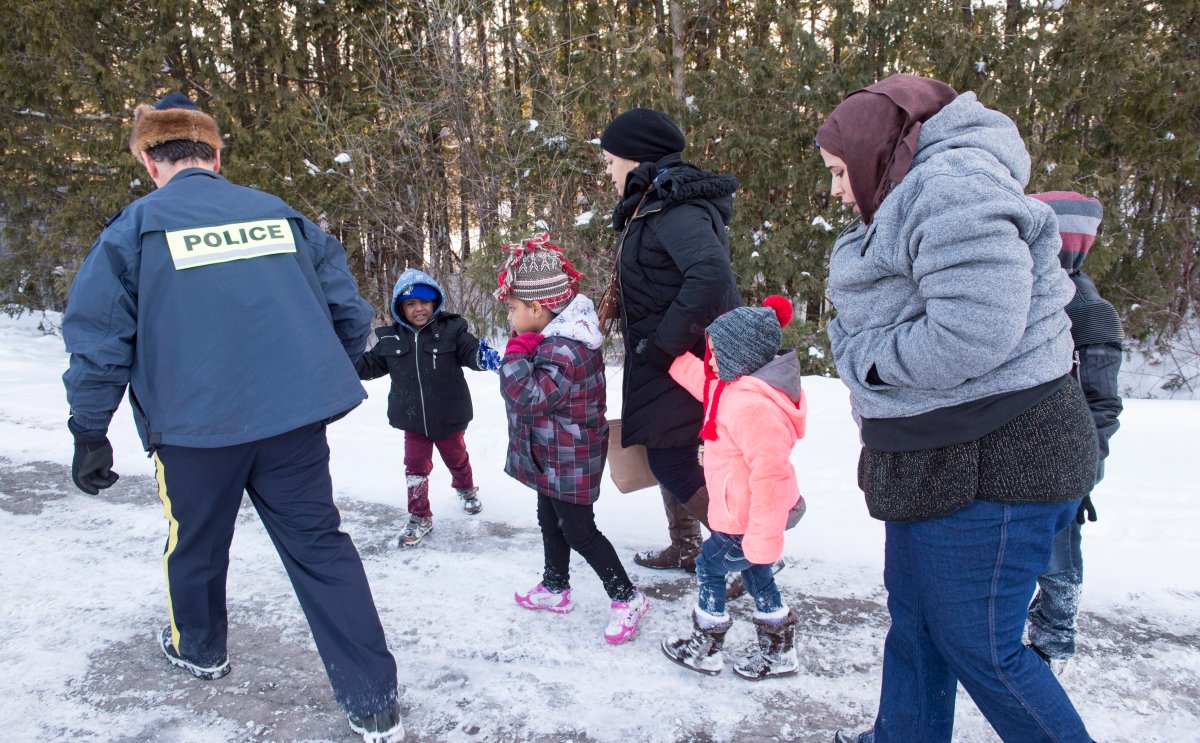The images are becoming increasingly prevalent; young men and women, sometimes entire families, appearing underdressed for an outdoor walk in Canada’s blistering February weather. Some drag bulging suitcases through the powdery snow, others carry plastic shopping bags.

These are the images of the growing number of men, women and children illegally crossing into Canada from the United States attempting to seek asylum.
In just one night over the weekend, 22 people were intercepted at the border near Emerson, Man., RCMP said. That added to the 21 who walked into the small community of fewer than 700 residents last weekend.
WATCH: How should the government respond to the growing number of people crossing into Quebec on foot to claim refugee status?

Why are they crossing in what looks like the middle of nowhere?
Canada and the U.S. signed an agreement 15 years ago effectively forcing refugee claimants to request protection in the first safe country they land. The agreement prevents claimants who were refused in one country from hopping the border to try in the other, or from claiming in both.
The agreement, called the Safe Third Country Agreement, applies only to refugee claimants trying to get into Canada from the U.S. at land border crossings, by train and at airports.
WATCH: Ottawa refuses to close loophole asylum seekers take advantage of

READ MORE: Tory MPs call on Liberals to stop influx of asylum seekers from US
There are some exceptions, mostly applied to ensuring families can remain united. But for the dozens and dozens of people who have recently come over, the Safe Third Party Agreement means they would be turned away at actual land borders. Their only hope of starting the asylum process in Canada is to walk over an unguarded section of the Canada-U.S. border.
Why now?
U.S. President Donald Trump made clear his administration’s feelings toward immigrants and refugees when he signed an executive order temporarily banning travel from seven predominantly Muslim countries and pausing the refugee system – with the plan to keep Syrians from entering the country indefinitely.
A judge has since blocked the implementation of key parts of the travel ban, but Trump has assured the public his office is coming back with a similar move against immigrants and refugees.
WATCH: Manitoba MP Ted Falk releases video calling on federal government to act on refugees

How many people are we talking about?
The Canadian Border Services Agency said more than 7,000 refugee applicants entered Canada from the U.S. through land ports in 2016. That marked a 63 per cent increase year over year, the agency said.
Another 2,000 entered by means similar to what Canadians are now witnessing – crossing the border without official authorization through unguarded sections of the border.
READ MORE: Emerson officials concerned for public safety after flood of refugees fleeing US
Manitoba and Quebec have experienced the highest volume of illegal crossings over the past few months. In Manitoba, 430 asylum seekers crossed over in the first nine months of 2016-17 (April 2016 to January 2017), up from the 340 who crossed over throughout the entire 2015-16 year.
In Quebec, 1,280 refugee claimants crossed into the province throughout the same nine-month period last year, a total three times more than the previous year, according to the CBSA.
British Columbia and Yukon are also experiencing an increase in asylum seekers crossing illegally from the U.S. In 2016, the 652 people who walked across the border represented a doubling of the previous year’s total.
What is Canada doing?
The federal Liberal government is hearing criticisms from both sides, with some Conservatives calling on Ottawa to protect and reinforce the border, while refugee advocates ask Ottawa to open its arms and accept as many claimants as possible.
Some groups, such as Amnesty International, the Canadian Council for Refugees and the Canadian Civil Liberties Association, have called on the Liberals to scrap the Safe Third Country Agreement.
WATCH: Refugees walking across B.C. border in fear of U.S. crackdown

They argue the agreement encourages would-be claimants to cross at unguarded points of the border, making the trek more dangerous. Under the current rules, however, sneaking in gives asylum seekers the best shot at getting their cases heard. If they crossed at regulated land borders, they would most likely be turned away on account of the Safe Third Country Agreement.
Immigration Minister Ahmed Hussen has said regardless of the trend at the border, the parameters of the safe third country designation remain intact. As such, the agreement will stand.
WATCH: Surge of refugees seek asylum in tiny Manitoba town

Public Safety Minister Ralph Goodale, meanwhile, has said the RCMP and CBSA are keeping a close watch on refugees crossing into Canada from the U.S.
Still, anyone who crosses the border without official authorization is arrested upon arrival, in accordance with the Immigration and Refugee Protection Act. Claimants are detained until criminal background checks are completed.
READ MORE: Refugees brave freezing cold, walk to Canada to escape Donald Trump’s USA
If the asylum seeker has a clean record – has not been convicted of a serious offence or had previous claims denied in Canada, for example – they will usually meet with a border officer and then begin the process of filing and having their claim heard.
WATCH: Montreal declares itself “sanctuary city” as influx of asylum seekers arrives

The entire process can take a few months – longer if the claim is denied and appealed.
Throughout the process, refugee claimants are entitled to health care, can apply for a special work permit and legal aid, and minors are automatically eligible to attend school.
With files from The Canadian Press and Reuters







Comments